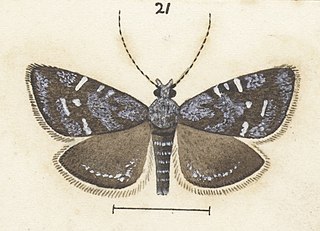
Asterivora symbolaea is a species of moth in the family Choreutidae. It is endemic to New Zealand and has been observed in Arthur's Pass. This species lives in subalpine habitat. Adults of this is on the wing in January and February. Larvae are hosted by Celmisia prorepens.
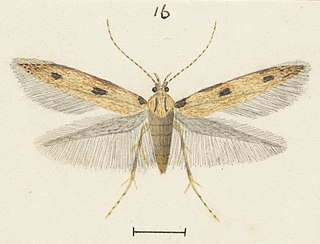
Labdia anarithma is a moth of the family Cosmopterigidae. It was described by Edward Meyrick in 1888. It is found in New Zealand and through out Australia. Adults are on the wing from December to March and are day flying. They have been collected by sweeping bracken fern.

Elachista eurychora is a species of moth in the family Elachistidae. This species is endemic to New Zealand and has only been collected at Paekākāriki. The habitat where the adult moth was originally collected was in rough vegetation on coastal sandhills or dunes but the collection locality has been significantly modified since that time. It has been hypothesised that the host of the larvae of this species is a grass. Adults are on the wing in March. It is classified as "Data Deficient" by the Department of Conservation.

Gymnobathra callixyla is a moth in the family Oecophoridae first described by Edward Meyrick in 1888. It is endemic to New Zealand.

Lepidoscia is a genus of bagworm moths in the family Psychidae. There are more than 40 described species in Lepidoscia, found primarily in Australia and New Zealand.

Tingena maranta is a species of moth in the family Oecophoridae. It is endemic to New Zealand and is found in the lower South Island. Adults of this species are on the wing from October until January. This species perfers grass or low herb habitat. Unlike its close relatives it does not inhabit native forest.

Barea exarcha is a moth of the family Oecophoridae. This species was first described by Edward Meyrick in 1883. It is found in Australia and New Zealand.

Eulechria zophoessa is a moth of the family Oecophoridae. It was first described by Edward Meyrick in 1883. This species is endemic to New Zealand. The classification of New Zealand endemic moths within the genus Eulechria is regarded as unsatisfactory and in need of revision. As such this species is currently also known as Eulechria (s.l.) zophoessa.

Leptocroca porophora is a moth of the family Oecophoridae first described by Edward Meyrick in 1929. It is endemic to New Zealand. The classification of this moth within the genus Leptocroca is regarded as unsatisfactory and in need of revision. As such this species is currently also known as Leptocroca (s.l.) porophora.
Mermeristis ocneropis is a moth of the family Oecophoridae first described by Edward Meyrick in 1936. It is endemic to New Zealand.
Mermeristis spodiaea is a moth of the family Oecophoridae first described by Edward Meyrick in 1915. It is found in Tasmania, Australia and New Zealand.
Leptocroca antinoma is a moth of the family Oecophoridae first described by Edward Meyrick in 1910. It is found in New Zealand at the Kermadec Islands and has also been collected in Australia.
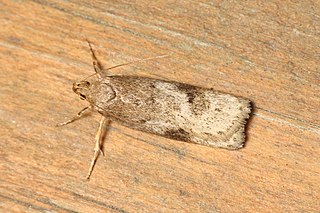
Phaeosaces apocrypta is a species of moth in the family Depressariidae. It was first described by Edward Meyrick in 1885. This species is endemic to New Zealand.

Trachypepla importuna is a moth of the family Oecophoridae first described by Edward Meyrick in 1892. This moth has been collected in Australia and is regarded as being introduced to New Zealand. The classification of this moth within the genus Trachypepla is regarded as unsatisfactory and in need of revision. As such this species is currently also known as Trachypepla (s.l.) indolescens.

Chrysorthenches drosochalca is a species of moth in the family Plutellidae first described by Edward Meyrick in 1905. It is endemic to New Zealand.
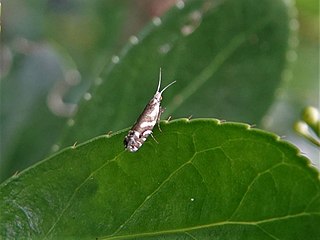
Chrysorthenches glypharcha is a species of moth in the family Plutellidae first described by Edward Meyrick in 1919. It is endemic to New Zealand.
Chrysorthenches glypharcha is a species of moth in the family Plutellidae first described by Edward Meyrick in 1919. It is endemic to New Zealand.
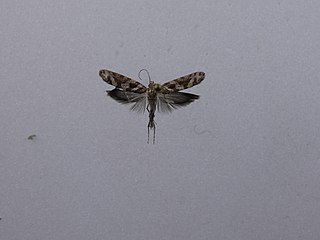
Chrysorthenches porphyritis is a species of moth in the family Plutellidae first described by Edward Meyrick in 1885. It is endemic to New Zealand.
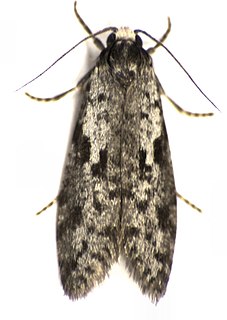
Lepidoscia protorna is a moth of the Psychidae family first described by Edward Meyrick in 1893. This species is native to Australia but has been found in New Zealand since 1978.















